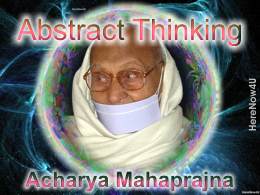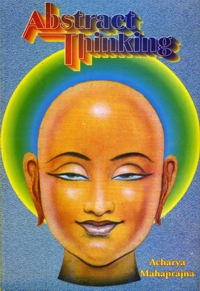
Anekanta sought a meeting-point between the two and expounded the rule that there is no total contradiction between the animate and the inanimate, nor is there a total non-contradiction. We cannot say that the animate is wholly contrary to the in animate, nor can we say that the inanimate is altogether contrary to the animate. Had they been totally in contradictory, the soul and the body would have existed apart from each other. The soul and the body are linked together because they are not wholly contradictory to each other. This question often arises in the philosophical world as to how an immaterial soul came to be linked with a material body. How could an immaterial soul be associated with material karma? How could the animate and conscious soul combine with the inanimate and unconscious body? No answer to this question is possible if we take the soul and the body to be contrary to each other. An answer is possible only if we accept them as not being wholly contradictory. Had they been wholly contradictory, how could they remain united?
The son said: "Oh Father! From today, I shan't take my meals with you." The father said: "Well, there is no difficulty about it. So long you have been taking your meals with me: from today onwards, I shall be taking my meals with you."
Similar is the relationship between the conscious and the unconscious. They are never separated, always united. Both make use of each other. The conscious utilizes the unconscious and the unconscious utilizes the conscious and the unconscious supports the conscious. The rule prescribes that there is no total contradiction between the two; that the two are not mutually exclusive, that there is also some community between them. All the real attributes are complementary to one another; only the modes are different. In terms of the manifested modes, we perceive difference - division and divergence everywhere. But in the context of the unmanifested modes, we perceive complete identity oneness everywhere.
Our living world is quite explicit. In the living world-the vegetable kingdom, living beings having two sense-organs, three, four, or five sense-organs, beasts, men, etc., -we witness difference and division everywhere, because we are looking at the manifested modes. But when we start looking in terms of the unmanifested mode, all differences disappear and what remains is only consciousness, which is the same in all living beings. There is consciousness in the vegetable world; in the insects and worms; in the beasts and in men. What remains common to them all, is consciousness - only consciousness. All coverings are removed. Only one thing remains; nothing else is left. There is identity, oneness-consciousness. All other differences disappear. Diversity and unity, dissimilarity and similarity relate to the analysis of mere modes. Matter contains both qualities at once-contradictoriness and non-contradictoriness, existence and non-existence, being and non-being, permanence andimpermanence - these pairs subsist together. The difference relates to the mode alone, to our particular approach. We perceive the gross mode and on that basis we analyse a particular object. We must fully understand that all our decisions, beliefs, concepts and theories are based upon gross principles. Let us not mistake them for eternal laws, for reality, or for the laws of the subtle world. Acharya Mahaprajna
Acharya Mahaprajna

